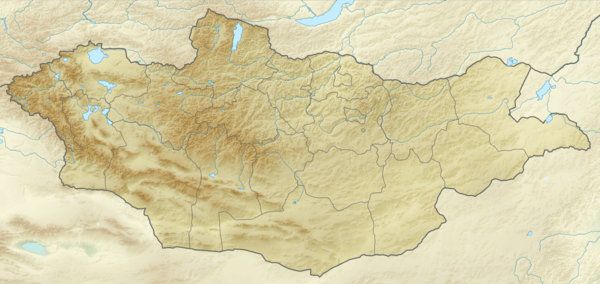Javkhlant Formation
The Javkhlant Formation is a geological formation in Mongolia whose strata date back to the Late Cretaceous possibly Santonian to Campanian. Yamaceratops dorngobiensis and Haya griva been found in the formation.[1][2] Also fossilized nesting sites were found in the formation.[3]
| Javkhlant Formation Stratigraphic range: Santonian-Campanian ~85 Ma | |
|---|---|
| Type | Geological formation |
| Overlies | Bayan Shireh Formation |
| Thickness | 380 m (1,250 ft) |
| Lithology | |
| Primary | Mudstone |
| Other | Sandstone, conglomerate |
| Location | |
| Coordinates | 44.4°N 109.4°E |
| Approximate paleocoordinates | 44.6°N 98.8°E |
| Region | Dornogov |
| Country | |
| Type section | |
| Named by | Khand et al. |
| Year defined | 2000 |
 Javkhlant Formation (Mongolia) | |
See also
- List of dinosaur-bearing rock formations
References
- Eberth et al., 2009
- Makovicky et al., 2011
- Tanaka et al., 2019
Bibliography
- Tanaka, K.; Y. Kobayashi; D.K. Zelenitsky; F. Therrien; Y.-N. Lee; R. Barsbold; K. Kubota; H.-J. Lee, and T. Chinzorig and D. Idersaikhan. 2019. Exceptional preservation of a Late Cretaceous dinosaur nesting site from Mongolia reveals colonial nesting behavior in a non-avian theropod. Geology 47. 843-847.
- Makovicky, Peter J.; Brandon M. Kilbourne; Rudyard W. Sadleir; Mark A. Norell (2011). "A new basal ornithopod (Dinosauria, Ornithischia) from the Late Cretaceous of Mongolia". Journal of Vertebrate Paleontology. 31 (3): 626–640. doi:10.1080/02724634.2011.557114.
- Eberth, D.A.; Y. Kobayashi; Y.N. Lee; O. Mateus; F. Therrien; D.K. Zelenitsky, and M.A. Norrell. 2009. Assignment of Yamaceratops dorngobiensis and associated redbeds at Shine Us Khudag (eastern Gobi, Dorngobi Province, Mongolia) to the redescribed Javkhlant Formation (Upper Cretaceous). Journal of Vertebrate Paleontology 29. 295–302. doi:10.1080/02724634.2009.10010384
This article is issued from Wikipedia. The text is licensed under Creative Commons - Attribution - Sharealike. Additional terms may apply for the media files.